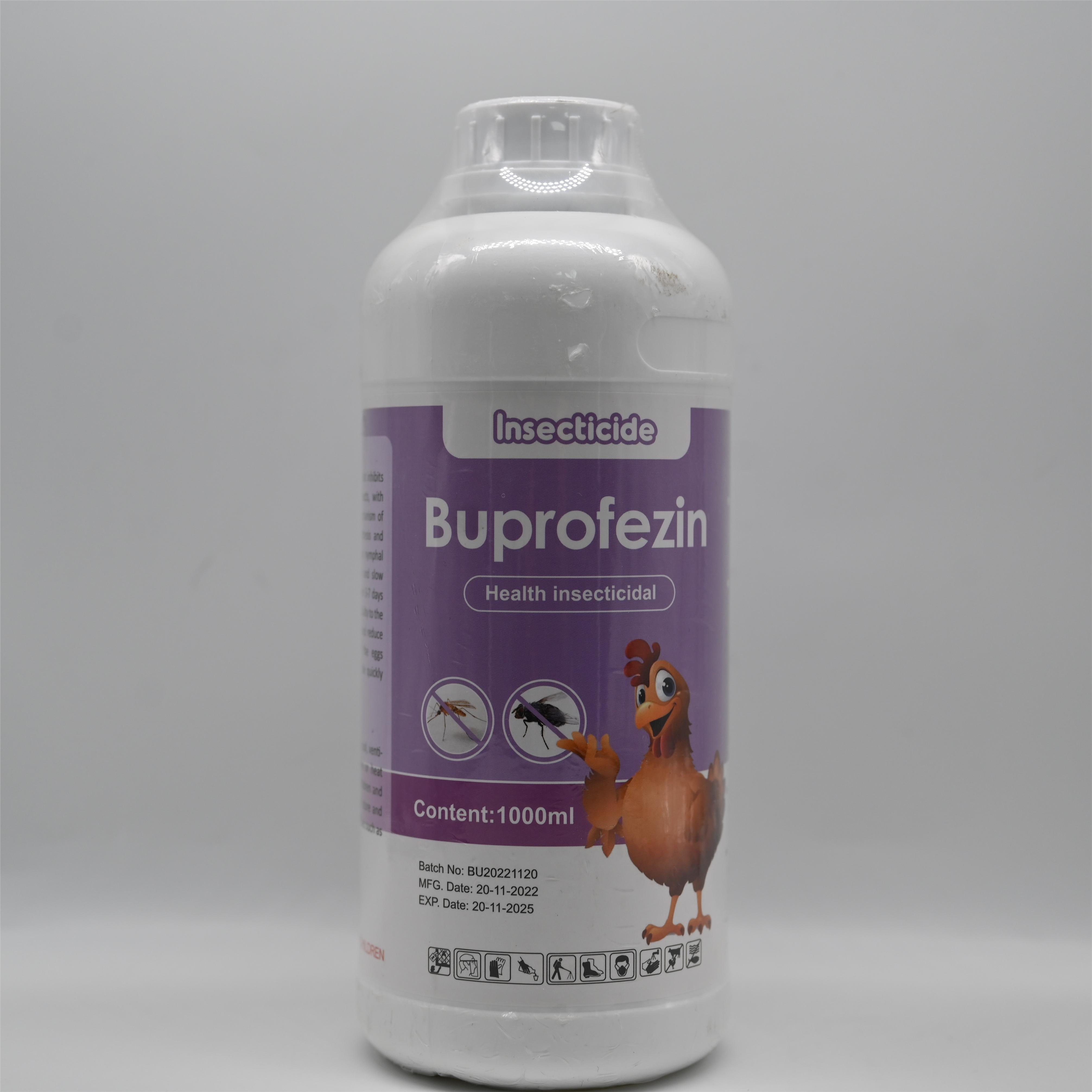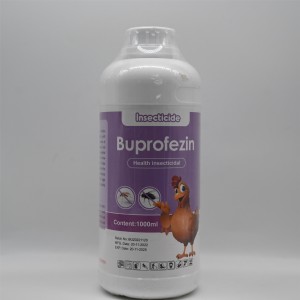Products
POMAIS Insecticide Buprofezin 25%SC | Agricultural Chemicals Pesticides
Introduction
Insecticide Buprofezin 25% SC is an insecticide for the control of a wide range of pests, with a significant effect on coleopteran pests (e.g. whiteflies, leafhoppers, mealybugs, etc.) Buprofezin 25% SC is an insecticide of the “Insect Growth Regulators Group”. It inhibits the molt of the larvae and insects, leading to their death. It is a persistent insecticide and acaricide with poisoning effects of touch and stomach; it is not translocated in plants. It also inhibits adult egg laying; treated insects lay sterile eggs. It is a new type of insecticide for Integrated Pest Management (IPM) and is safe for the environment.
| Active Ingredient | Buprofezin 25%SC |
| CAS Number | 69327-76-0 |
| Molecular Formula | C16H23N3SO |
| Application | Insect growth regulator insecticides |
| Brand Name | POMAIS |
| Shelf life | 2 Years |
| Purity | 25% SC |
| State | Liquid |
| Label | Customized |
| Formulations | 25%WP,50%WP,65%WP,80%WP,25%SC,37%SC,40%SC,50%SC,70%WDG,955TC,98%TC |
Main features
High selectivity: mainly against Homoptera pests, safer for non-target organisms such as bees.
Long persistence period: generally one application can continue to control pests for 2-3 weeks, effectively reducing the number of applications.
Environmentally friendly: Compared with other insecticides, it has lower toxicity to the environment and human and animal, and is a more environmentally friendly choice.
Environmental protection and safety
Toxicity to humans and animals: It is a low-toxicity pesticide with high safety for humans and animals.
Environmental impact: more friendly to the environment, moderate degradation rate, not easy to accumulate in the soil and water.
Mode of Action
Buprofezin is an IRAC Group 16 IGR that inhibits chitin biosynthesis, interrupting normal molting and cuticle formation. Susceptible nymphs fail at the next molt and populations decline even when immediate knockdown is not obvious. Additional reproductive effects include suppressed oviposition and reduced egg viability, which help stabilize pressure between service intervals. Because the active is non-systemic and not a neurotoxin, results pivot on spray coverage, life-stage targeting, and program cadence rather than on fast knockdown. Stewardship requires rotation with non-16 tools as permitted by the label to slow resistance selection.
Target Pests
This 25% SC is positioned for whiteflies (adults/larvae focus on immature stages), planthoppers, leafhoppers, scales, and mealybugs, depending on local registration. Best field economics come from early interventions when nymphal stages dominate and competing food or honeydew is controlled through sanitation. Use monitoring cards, visual scouting, and threshold rules to trigger label-guided applications and verify trend reduction.




Use Areas
Deploy on registered crops and ornamental sites only (e.g., rice, citrus, cotton, vegetables, tea, fruit trees, ornamentals where listed). Adhere to pre-harvest intervals, application intervals, and maximum seasonal totals in the destination-market label. Align spray timing with weather, irrigation, and canopy conditions to maximize contact with immature stages on leaf undersides and protected feeding sites.

Application & Program
Follow the local label for rates, timing, and spray volumes; do not exceed label loads. Because buprofezin is non-systemic, prioritize uniform coverage, appropriate water volumes, and nozzle selection that reaches the target life stages. For first-time mixes, conduct a jar test; avoid strong acids/alkalis and unverified partners. Integrate with IPM: inspection, sanitation (remove honeydew/sooty molds that shield pests), and rotation with non-IRAC 16 tools. Record lot numbers, dates, weather, pest stages, and outcomes to support audits and program tuning.
Safety & Stewardship
Use label-specified PPE and follow the SDS for handling and storage. Prevent drift or runoff to water bodies; do not contaminate drinking water systems. Buprofezin can be harmful to silkworms and some fish—do not use in or near mulberry or sericulture operations, and protect aquatic environments according to local rules. Respect re-entry and any harvest intervals on the label. Dispose of rinsates and containers via approved channels.
OEM & Documentation
Speed market entry with private-label OEM, multilingual artwork, and barcoding/QR. Each lot ships with COA / MSDS (SDS) / TDS and batch traceability to streamline inbound QA. We confirm lead-time windows and MOQ at quotation and coordinate production slots for seasonal demand. Palletization notes are available to optimize container loading and warehouse flow.
Using Method
1. To control scale insects and whiteflies such as citrus sagittal scales and whiteflies on fruit trees, use 25% Buprofezin SC (wettable powder) 800 to 1200 times liquid or 37% Buprofezin SC 1200 to 1500 times liquid spray. When controlling scale insects such as the sagittal scale, spray before the pests emerge or in the early stages of nymph emergence. Spray once per generation. When controlling whiteflies, start spraying from the beginning of whiteflies, once every 15 days, and spray twice in a row, focusing on the back of the leaves.
To control scale insects and small green leafhoppers such as peach, plum and apricot mulberry scales, use 25% Buprofezin SC (wettable powder) 800~1200 times liquid spray. When controlling scale insects such as the white mulberry scale insect, spray pesticides promptly after the nymphs hatch to the young nymph stage. Spray once per generation. When controlling small green leafhoppers, spray in time when the pest is at its peak or when more yellow-green dots appear on the front of the leaves. Once every 15 days, spray twice in a row, focusing on the back of the leaves.
2. Rice pest control: rice white-backed planthoppers and leafhoppers: spray once during the peak period of the main pest generation of young nymphs. Use 50 grams of 25% Buprofezin wettable powder per acre, mix with 60 kilograms of water and spray evenly. Focus on spraying the middle and lower parts of the plant.
To prevent and control rice brown planthopper, spraying once each from the egg hatching period of the main generation and the previous generation to the peak emergence period of young nymphs can effectively control its damage. Use 50 to 80 grams of 25% Buprofezin wettable powder per acre, mix with 60 kilograms of water and spray, focusing on the middle and lower parts of the plants.
3. When controlling tea tree pests such as green leafhoppers, black thorn whiteflies and gall mites, use pesticides during the non-picking period of tea leaves and the young stages of pests. Use 1000 to 1200 times of 25% Buprofezin wettable powder to spray evenly.
Precautions
1. Buprofezin has no systemic conduction effect and requires uniform and thorough spraying.
2. Do not use it on cabbage and radish, otherwise it will cause brown spots or green leaves to turn white.
3. Cannot be mixed with alkaline agents and strong acid agents. It should not be used multiple times, continuously, or in high doses. Generally, it should only be used once or twice a year. When spraying continuously, be sure to alternate or mix pesticides with different insecticidal mechanisms to delay the development of drug resistance in pests.
4. The medicine should be kept in a cool, dry place and out of the reach of children.
5. This medicine should only be used as a spray and cannot be used as a poisonous soil method.
6. Toxic to silkworms and some fish, it is prohibited in mulberry gardens, silkworm rooms and surrounding areas to prevent the liquid from contaminating water sources and rivers. It is prohibited to discharge pesticide application field water and waste liquid from cleaning pesticide application equipment into rivers, ponds and other waters.
7. Generally, the crop safety interval is 7 days, and it should be used twice a season.
FAQ
Q1. Is this product systemic?
No. It is non-systemic; consistent spray coverage and life-stage targeting are essential.
Q2. Which life stages are most affected?
Primarily nymphs/immatures, with suppressed oviposition and reduced egg viability contributing to population decline.
Q3. Can I mix it with other insecticides or adjuvants?
Only if the label permits. Always jar-test first; avoid strong acids/alkalis and unverified partners.
Q4. Any non-target cautions?
Protect silkworms and aquatic organisms; keep applications away from mulberry/sericulture and water bodies per local regulation.
Q5. Documentation and OEM?
We provide COA / MSDS (SDS) / TDS with each lot and support private-label activation with multilingual artwork and barcoding/QR.
Q6. Pack sizes and MOQ?
Standard packs are 1 L / 100 mL; MOQ 500 L, confirmed at quotation along with lead-time windows.
Why Choose US
Request your spec sheet, label templates, samples, and a confirmed MOQ/lead-time window. Share your target crops/sites, pest spectrum, and pack preferences—we will align formulation, branding, and logistics to your market plan. Always follow the product label and local regulations.










